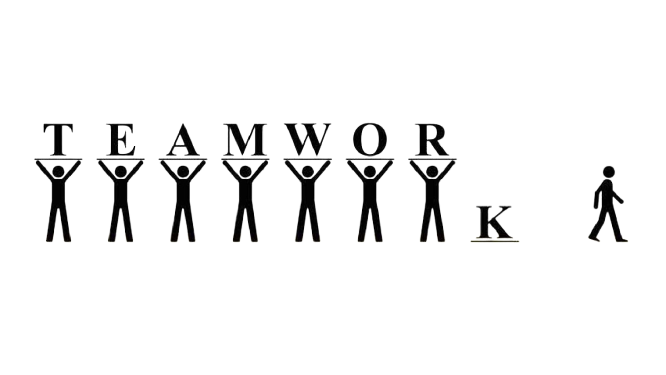Conscious Leadership Scenario:
What matters most isn’t the personalities or behavior of the team members; it’s whether a team has a clear direction, a strong structure, and a supportive context. Over the years, as teams have grown more diverse, dispersed, digital, and dynamic, collaboration has become more complex. Though teams face new challenges, their success still depends on a core set of fundamentals. The core of these fundamentals always comes down when our “I” turns into a constant thought and actionable point of “We.”
For me, this realization began when I came into a relationship with my “ego.” Developing a deeper understanding of when my “I” was driving harder than my “We” and how this toxic mindset drove my team further from a shared mindset diminishing my team’s effectiveness and shared direction.
My entire decision process each moment of each day is based upon this mindset: Are the decisions I’m making based on “Me” or “We?”
The successes and focus of We-Teams versus I-Teams is shared in this article.

Leadership Fail:
Is your Ego overpowering your “We?”
We are buried in corporate goals, division goals, personal goals, maintaining budgets, and managing your team to gain the ultimate competitive advantage. The building, mentoring, and nurturing of our team takes an immense amount of time. Will we choose to slow down and invest the proper amount of time developing a relationship with our ego and having awareness when our “I” is overpowering the “We?”
Negative Affect “I” has on Culture and Organizational Performance:
- Team members that share an “I” mindset conceal their weaknesses and mistakes from one another.
- Hesitate to ask for help or provide constructive feedback to other essential team members.
- Hesitate to help outside of their own areas of responsibility.
- Hold grudges that take away from the team’s effectiveness.
- Dread meetings and avoid spending time with their team members.
- Waste time and energy managing their behaviors for their own self good.
Conscious Leadership Solution:
Creating a “We-Team” Culture…
“WE-Teams” Creates a Compelling Direction:
The foundation of every great We-Team is a direction that energizes, orients, and engages its members. We-Teams cannot be inspired if they don’t know what they’re working toward and don’t have explicit goals. Those goals should be challenging (modest ones don’t motivate) but not so complex that the team becomes dispirited. They also must be consequential: People have to care about achieving a goal whether because they stand to gain extrinsic rewards, like recognition, pay, and promotions, or intrinsic rewards, such as satisfaction and a sense of meaning.
“WE-Team’s” Create a Strong Structure:
We-Teams also need the right mix and number of members; optimally designed tasks and processes, norms that discourage destructive behavior and promote positive dynamics.

High-performing We-Teams include members with a balance of skills. Every individual doesn’t have to possess excellent technical and social skills, but the team overall needs a healthy dose of both. Diversity in knowledge, views, perspectives, age, gender, and race can help teams be more creative. We-Team members from diverse backgrounds
often interpret a group’s goals differently. This diversity is critical in a 10-D We-Team.
“WE-Team’s” Have Increased Effective Communication:
Larger We-Teams is of course one way to ensure that a team has the requisite skills and diversity, but increased size can come with costs. Larger groups are more vulnerable to poor communication, fragmentation, and free-riding (due to a lack of accountability). I frequently hear managers lament that teams become bloated as global experts are pulled in, and more members are recruited to increase buy-in from different locations, divisions, or functions. We-Team leaders must be vigilant about adding members only when necessary, and the added team members must have the We-Team focus.
WE-TEAM’s Have a Shared Mindset:
Establishing the first three enabling conditions (compelling direction, strong structure, and effective communication) will pave the way for We-Team’s success, but today’s We-Teams need something more. Distance and diversity and digital communication and changing membership make We-Team’s especially prone to the problems of “us versus them” thinking and incomplete information. The solution to both is developing a shared mindset among We-Team members—something We-Team leaders can do by fostering a common identity and common understanding.
Fortunately, there are many ways We-Team leaders can actively foster a shared identity and shared understanding and break down the barriers to the I-Team mentality. One powerful approach is to ensure that each subgroup of your team feels valued for its contributions toward the We-Team’s overall goals. This is accomplished with vulnerability and heartfelt leadership.
We are here to help. For us, our purpose is leadership for a better world, and we are here to help you in showing up as the We-Team leader you need to be. We are here to support you globally. We are on this journey together. This is an invitation, an invitation to join us in creating a collaborative movement: the movement that is leadership for a better world.

Live2Lead/OneTribe
Travis
Great article, Travis. Thank you for sharing. Sounds like congratulations are in order as well on the new position at TriSearch. Excited to see your journey that awaits!